Assessment (Project Management)
VerifiedAdded on 2023/01/13
|19
|2994
|80
AI Summary
Contribute Materials
Your contribution can guide someone’s learning journey. Share your
documents today.
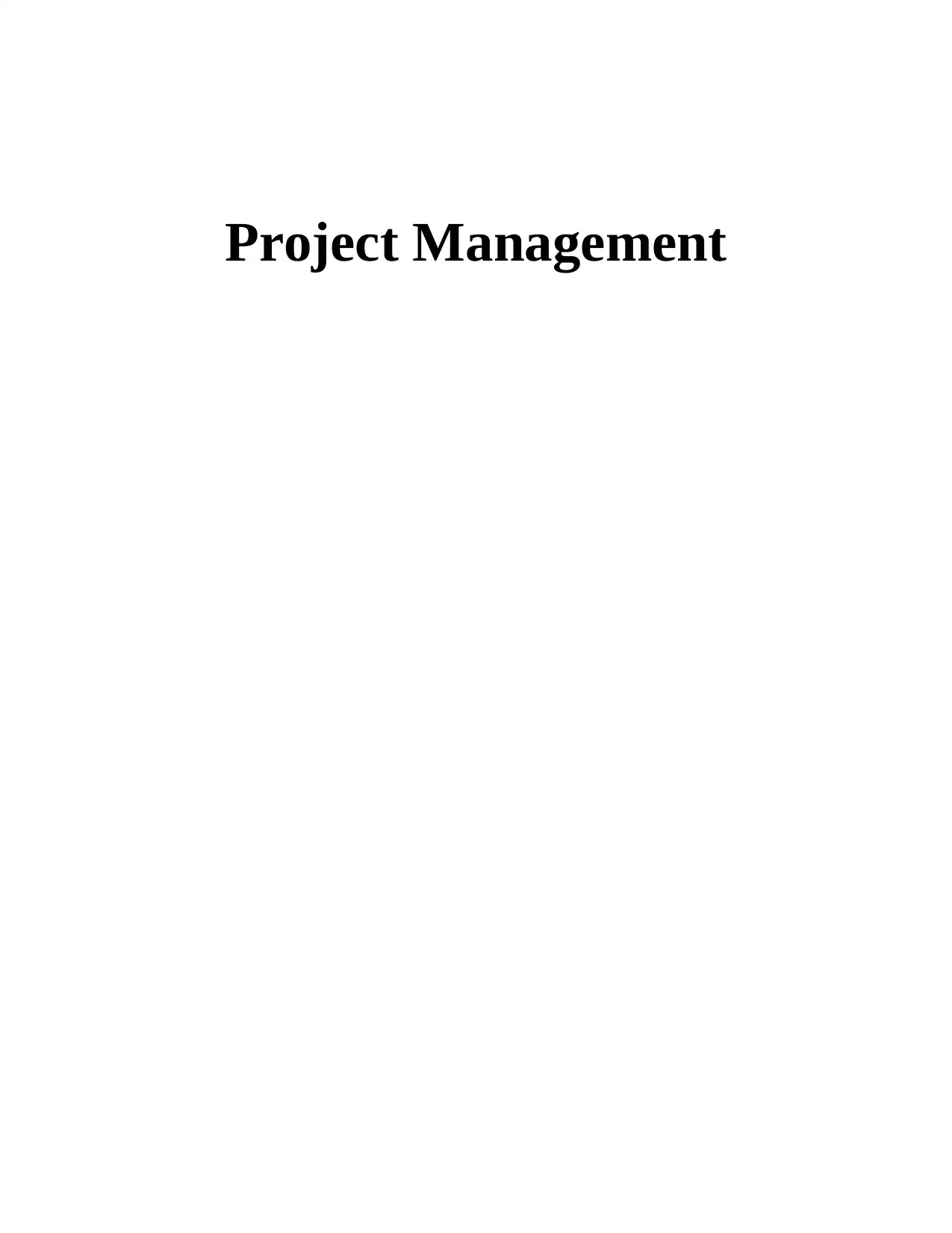
Project Management
Secure Best Marks with AI Grader
Need help grading? Try our AI Grader for instant feedback on your assignments.
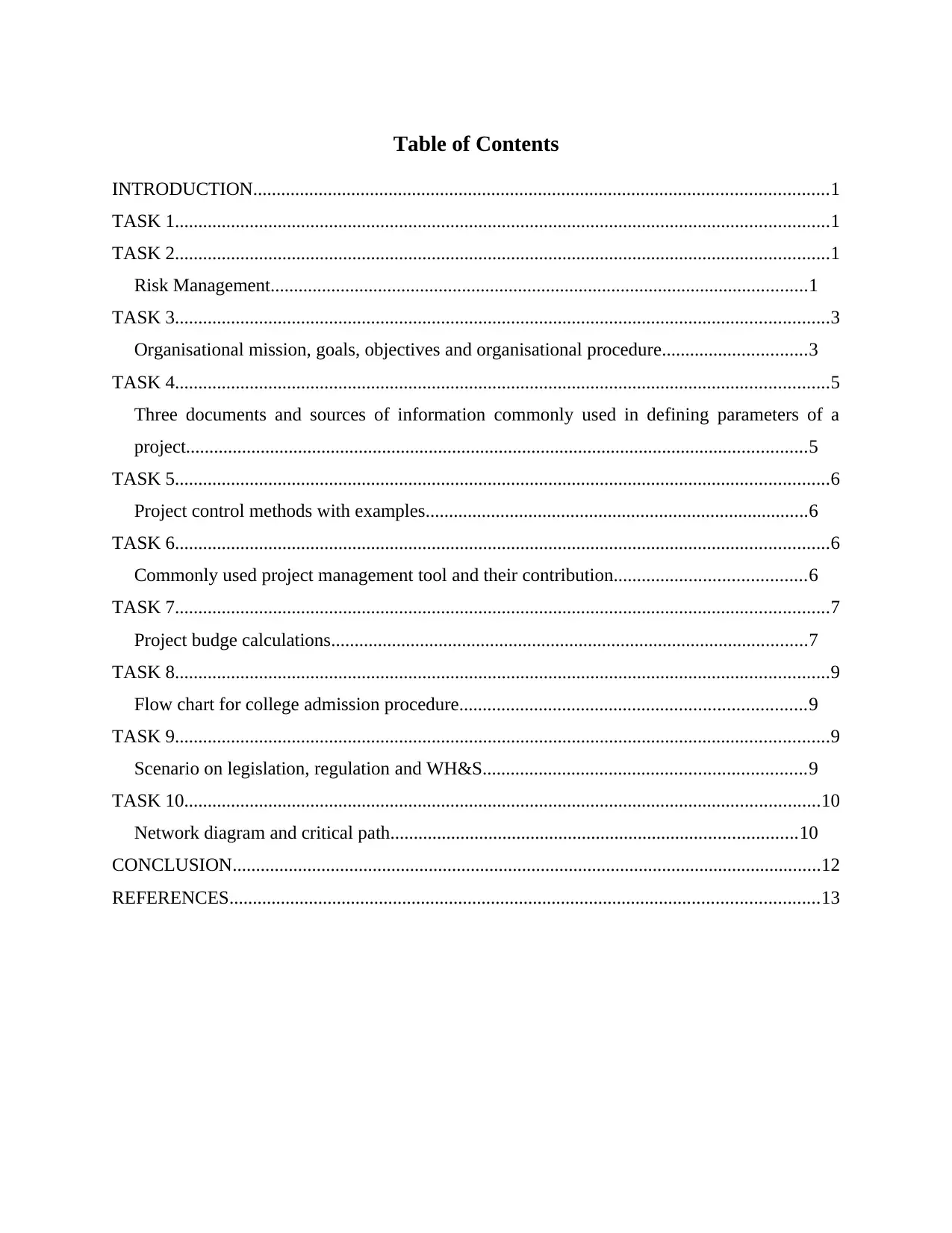
Table of Contents
INTRODUCTION...........................................................................................................................1
TASK 1............................................................................................................................................1
TASK 2............................................................................................................................................1
Risk Management...................................................................................................................1
TASK 3............................................................................................................................................3
Organisational mission, goals, objectives and organisational procedure...............................3
TASK 4............................................................................................................................................5
Three documents and sources of information commonly used in defining parameters of a
project.....................................................................................................................................5
TASK 5............................................................................................................................................6
Project control methods with examples..................................................................................6
TASK 6............................................................................................................................................6
Commonly used project management tool and their contribution.........................................6
TASK 7............................................................................................................................................7
Project budge calculations......................................................................................................7
TASK 8............................................................................................................................................9
Flow chart for college admission procedure..........................................................................9
TASK 9............................................................................................................................................9
Scenario on legislation, regulation and WH&S.....................................................................9
TASK 10........................................................................................................................................10
Network diagram and critical path.......................................................................................10
CONCLUSION..............................................................................................................................12
REFERENCES..............................................................................................................................13
INTRODUCTION...........................................................................................................................1
TASK 1............................................................................................................................................1
TASK 2............................................................................................................................................1
Risk Management...................................................................................................................1
TASK 3............................................................................................................................................3
Organisational mission, goals, objectives and organisational procedure...............................3
TASK 4............................................................................................................................................5
Three documents and sources of information commonly used in defining parameters of a
project.....................................................................................................................................5
TASK 5............................................................................................................................................6
Project control methods with examples..................................................................................6
TASK 6............................................................................................................................................6
Commonly used project management tool and their contribution.........................................6
TASK 7............................................................................................................................................7
Project budge calculations......................................................................................................7
TASK 8............................................................................................................................................9
Flow chart for college admission procedure..........................................................................9
TASK 9............................................................................................................................................9
Scenario on legislation, regulation and WH&S.....................................................................9
TASK 10........................................................................................................................................10
Network diagram and critical path.......................................................................................10
CONCLUSION..............................................................................................................................12
REFERENCES..............................................................................................................................13
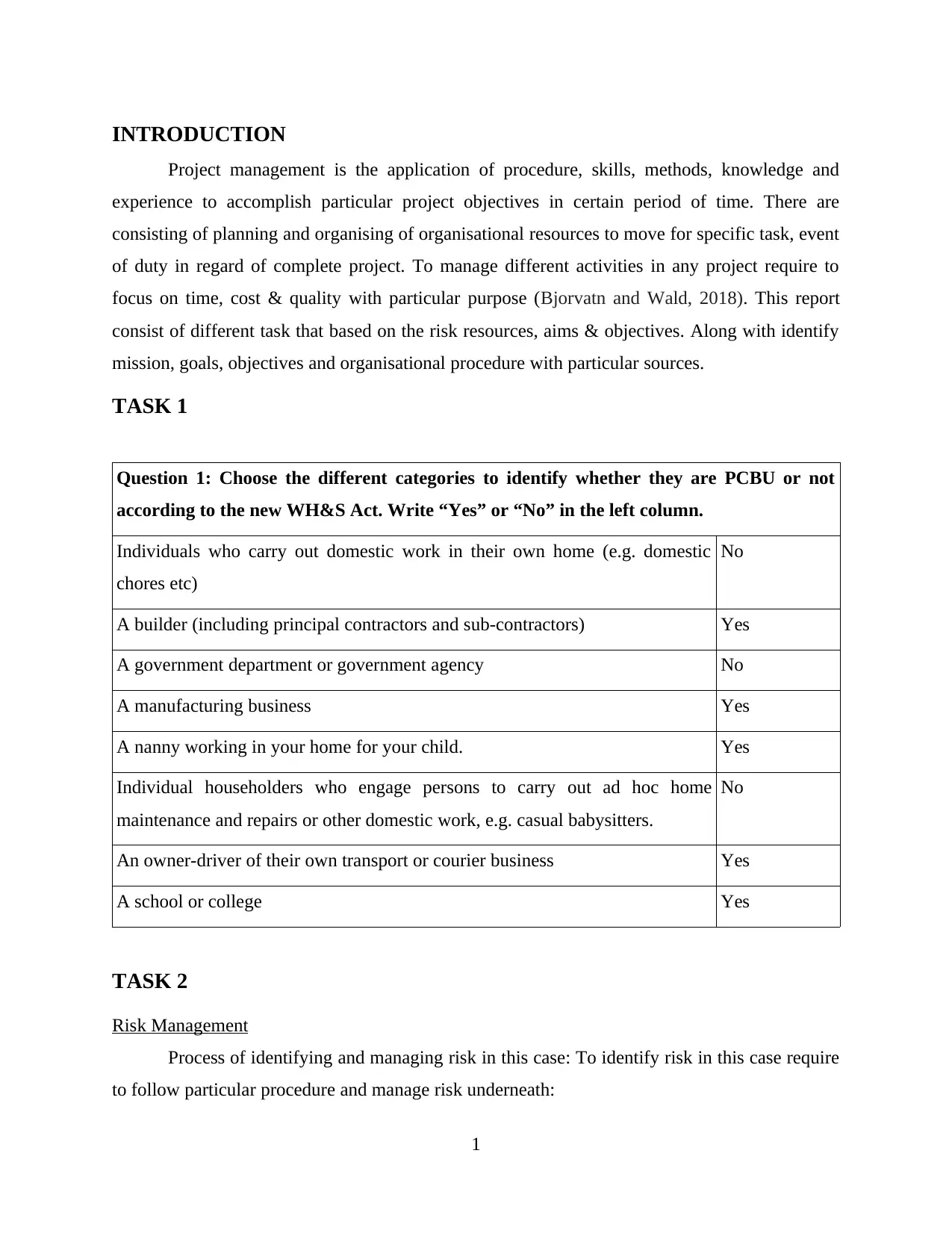
INTRODUCTION
Project management is the application of procedure, skills, methods, knowledge and
experience to accomplish particular project objectives in certain period of time. There are
consisting of planning and organising of organisational resources to move for specific task, event
of duty in regard of complete project. To manage different activities in any project require to
focus on time, cost & quality with particular purpose (Bjorvatn and Wald, 2018). This report
consist of different task that based on the risk resources, aims & objectives. Along with identify
mission, goals, objectives and organisational procedure with particular sources.
TASK 1
Question 1: Choose the different categories to identify whether they are PCBU or not
according to the new WH&S Act. Write “Yes” or “No” in the left column.
Individuals who carry out domestic work in their own home (e.g. domestic
chores etc)
No
A builder (including principal contractors and sub-contractors) Yes
A government department or government agency No
A manufacturing business Yes
A nanny working in your home for your child. Yes
Individual householders who engage persons to carry out ad hoc home
maintenance and repairs or other domestic work, e.g. casual babysitters.
No
An owner-driver of their own transport or courier business Yes
A school or college Yes
TASK 2
Risk Management
Process of identifying and managing risk in this case: To identify risk in this case require
to follow particular procedure and manage risk underneath:
1
Project management is the application of procedure, skills, methods, knowledge and
experience to accomplish particular project objectives in certain period of time. There are
consisting of planning and organising of organisational resources to move for specific task, event
of duty in regard of complete project. To manage different activities in any project require to
focus on time, cost & quality with particular purpose (Bjorvatn and Wald, 2018). This report
consist of different task that based on the risk resources, aims & objectives. Along with identify
mission, goals, objectives and organisational procedure with particular sources.
TASK 1
Question 1: Choose the different categories to identify whether they are PCBU or not
according to the new WH&S Act. Write “Yes” or “No” in the left column.
Individuals who carry out domestic work in their own home (e.g. domestic
chores etc)
No
A builder (including principal contractors and sub-contractors) Yes
A government department or government agency No
A manufacturing business Yes
A nanny working in your home for your child. Yes
Individual householders who engage persons to carry out ad hoc home
maintenance and repairs or other domestic work, e.g. casual babysitters.
No
An owner-driver of their own transport or courier business Yes
A school or college Yes
TASK 2
Risk Management
Process of identifying and managing risk in this case: To identify risk in this case require
to follow particular procedure and manage risk underneath:
1
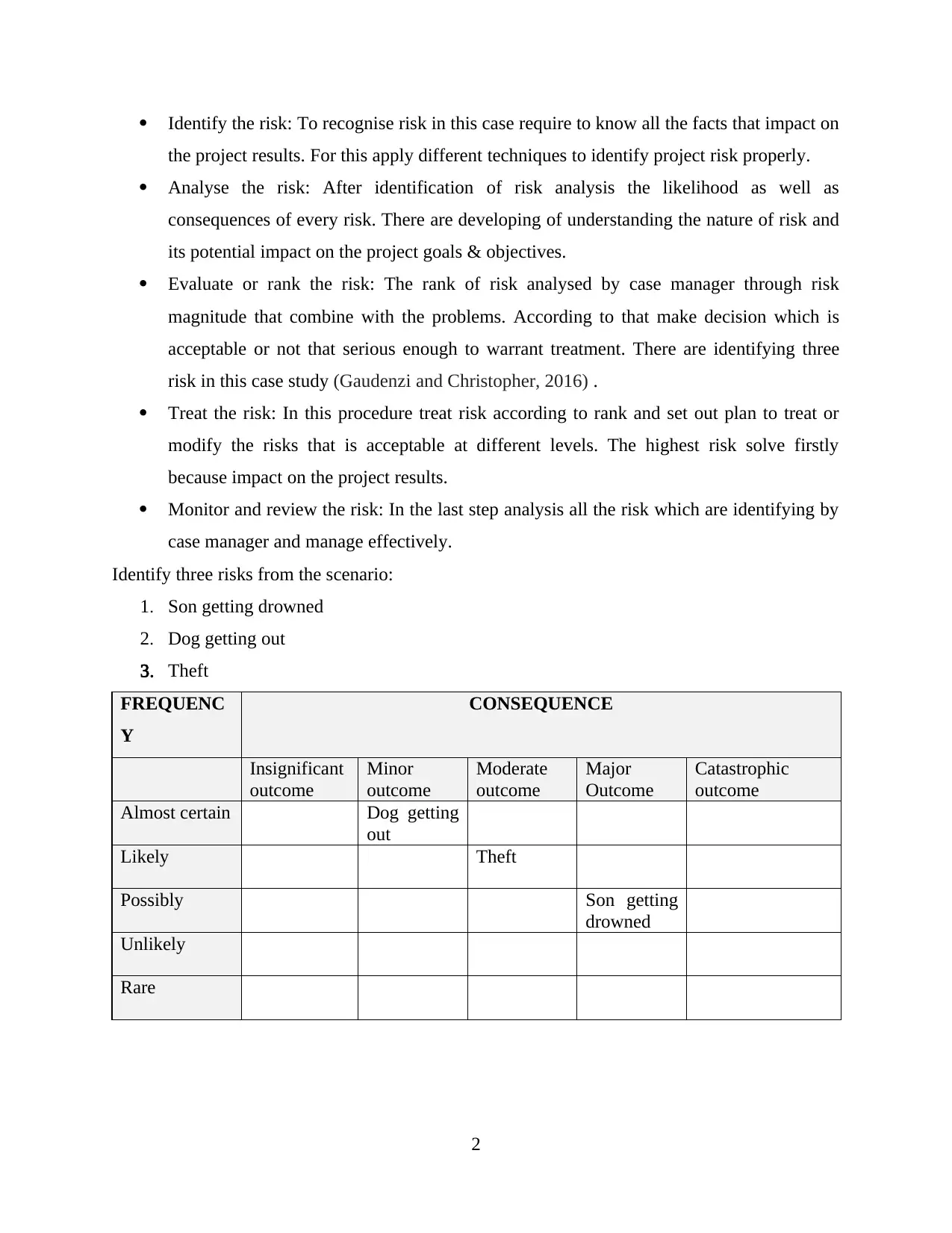
Identify the risk: To recognise risk in this case require to know all the facts that impact on
the project results. For this apply different techniques to identify project risk properly.
Analyse the risk: After identification of risk analysis the likelihood as well as
consequences of every risk. There are developing of understanding the nature of risk and
its potential impact on the project goals & objectives.
Evaluate or rank the risk: The rank of risk analysed by case manager through risk
magnitude that combine with the problems. According to that make decision which is
acceptable or not that serious enough to warrant treatment. There are identifying three
risk in this case study (Gaudenzi and Christopher, 2016) .
Treat the risk: In this procedure treat risk according to rank and set out plan to treat or
modify the risks that is acceptable at different levels. The highest risk solve firstly
because impact on the project results.
Monitor and review the risk: In the last step analysis all the risk which are identifying by
case manager and manage effectively.
Identify three risks from the scenario:
1. Son getting drowned
2. Dog getting out
3. Theft
FREQUENC
Y
CONSEQUENCE
Insignificant
outcome
Minor
outcome
Moderate
outcome
Major
Outcome
Catastrophic
outcome
Almost certain Dog getting
out
Likely Theft
Possibly Son getting
drowned
Unlikely
Rare
2
the project results. For this apply different techniques to identify project risk properly.
Analyse the risk: After identification of risk analysis the likelihood as well as
consequences of every risk. There are developing of understanding the nature of risk and
its potential impact on the project goals & objectives.
Evaluate or rank the risk: The rank of risk analysed by case manager through risk
magnitude that combine with the problems. According to that make decision which is
acceptable or not that serious enough to warrant treatment. There are identifying three
risk in this case study (Gaudenzi and Christopher, 2016) .
Treat the risk: In this procedure treat risk according to rank and set out plan to treat or
modify the risks that is acceptable at different levels. The highest risk solve firstly
because impact on the project results.
Monitor and review the risk: In the last step analysis all the risk which are identifying by
case manager and manage effectively.
Identify three risks from the scenario:
1. Son getting drowned
2. Dog getting out
3. Theft
FREQUENC
Y
CONSEQUENCE
Insignificant
outcome
Minor
outcome
Moderate
outcome
Major
Outcome
Catastrophic
outcome
Almost certain Dog getting
out
Likely Theft
Possibly Son getting
drowned
Unlikely
Rare
2
Secure Best Marks with AI Grader
Need help grading? Try our AI Grader for instant feedback on your assignments.
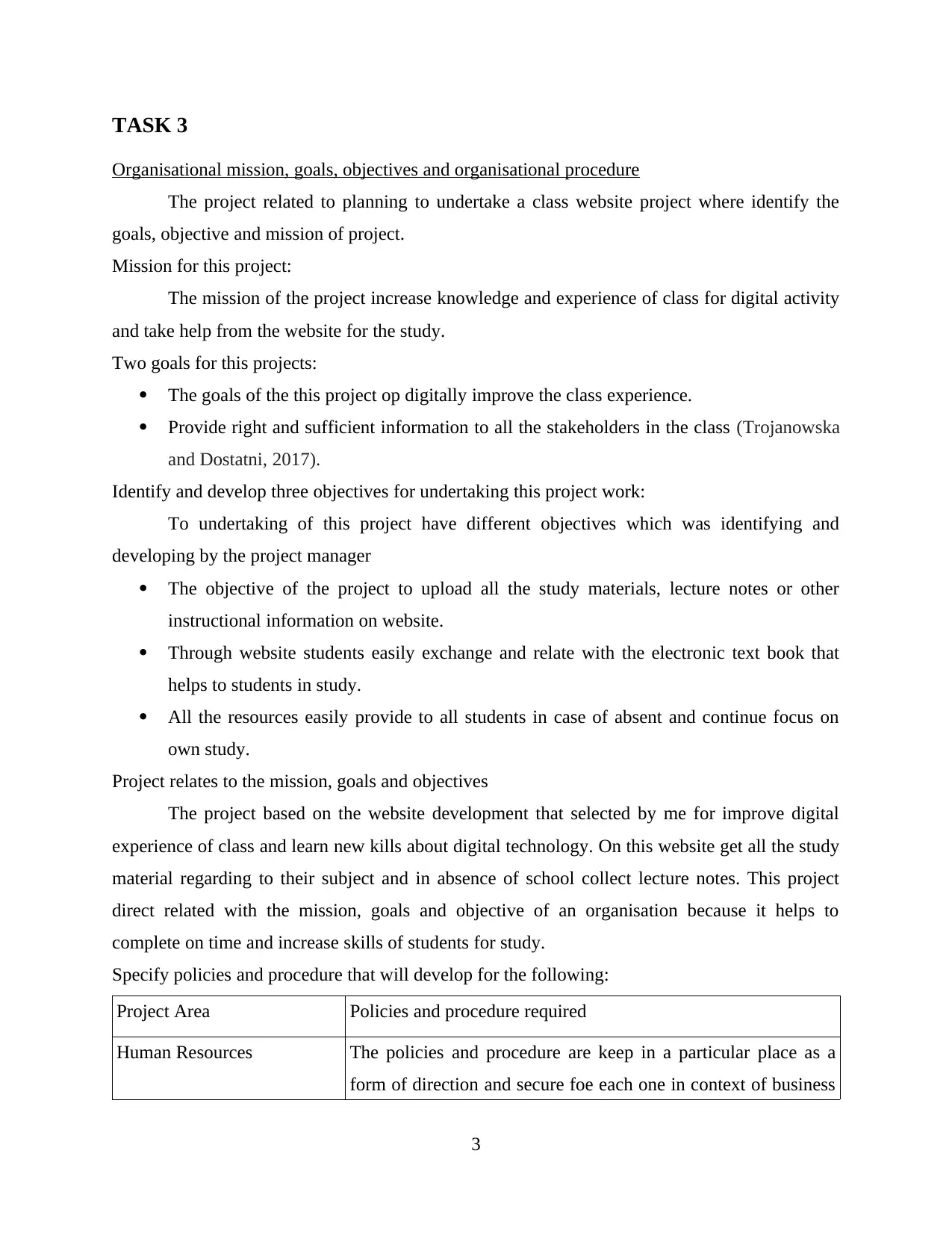
TASK 3
Organisational mission, goals, objectives and organisational procedure
The project related to planning to undertake a class website project where identify the
goals, objective and mission of project.
Mission for this project:
The mission of the project increase knowledge and experience of class for digital activity
and take help from the website for the study.
Two goals for this projects:
The goals of the this project op digitally improve the class experience.
Provide right and sufficient information to all the stakeholders in the class (Trojanowska
and Dostatni, 2017).
Identify and develop three objectives for undertaking this project work:
To undertaking of this project have different objectives which was identifying and
developing by the project manager
The objective of the project to upload all the study materials, lecture notes or other
instructional information on website.
Through website students easily exchange and relate with the electronic text book that
helps to students in study.
All the resources easily provide to all students in case of absent and continue focus on
own study.
Project relates to the mission, goals and objectives
The project based on the website development that selected by me for improve digital
experience of class and learn new kills about digital technology. On this website get all the study
material regarding to their subject and in absence of school collect lecture notes. This project
direct related with the mission, goals and objective of an organisation because it helps to
complete on time and increase skills of students for study.
Specify policies and procedure that will develop for the following:
Project Area Policies and procedure required
Human Resources The policies and procedure are keep in a particular place as a
form of direction and secure foe each one in context of business
3
Organisational mission, goals, objectives and organisational procedure
The project related to planning to undertake a class website project where identify the
goals, objective and mission of project.
Mission for this project:
The mission of the project increase knowledge and experience of class for digital activity
and take help from the website for the study.
Two goals for this projects:
The goals of the this project op digitally improve the class experience.
Provide right and sufficient information to all the stakeholders in the class (Trojanowska
and Dostatni, 2017).
Identify and develop three objectives for undertaking this project work:
To undertaking of this project have different objectives which was identifying and
developing by the project manager
The objective of the project to upload all the study materials, lecture notes or other
instructional information on website.
Through website students easily exchange and relate with the electronic text book that
helps to students in study.
All the resources easily provide to all students in case of absent and continue focus on
own study.
Project relates to the mission, goals and objectives
The project based on the website development that selected by me for improve digital
experience of class and learn new kills about digital technology. On this website get all the study
material regarding to their subject and in absence of school collect lecture notes. This project
direct related with the mission, goals and objective of an organisation because it helps to
complete on time and increase skills of students for study.
Specify policies and procedure that will develop for the following:
Project Area Policies and procedure required
Human Resources The policies and procedure are keep in a particular place as a
form of direction and secure foe each one in context of business
3
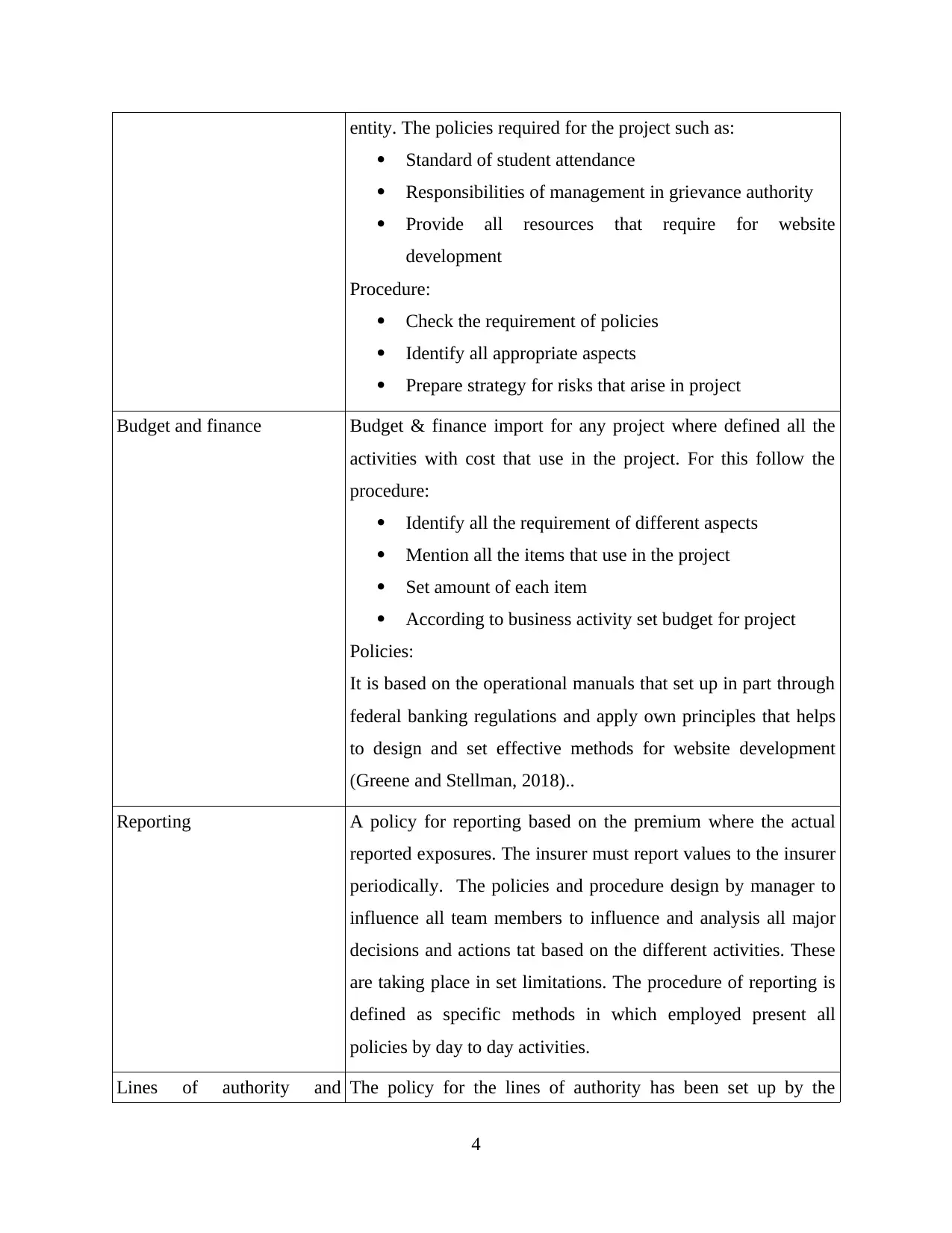
entity. The policies required for the project such as:
Standard of student attendance
Responsibilities of management in grievance authority
Provide all resources that require for website
development
Procedure:
Check the requirement of policies
Identify all appropriate aspects
Prepare strategy for risks that arise in project
Budget and finance Budget & finance import for any project where defined all the
activities with cost that use in the project. For this follow the
procedure:
Identify all the requirement of different aspects
Mention all the items that use in the project
Set amount of each item
According to business activity set budget for project
Policies:
It is based on the operational manuals that set up in part through
federal banking regulations and apply own principles that helps
to design and set effective methods for website development
(Greene and Stellman, 2018)..
Reporting A policy for reporting based on the premium where the actual
reported exposures. The insurer must report values to the insurer
periodically. The policies and procedure design by manager to
influence all team members to influence and analysis all major
decisions and actions tat based on the different activities. These
are taking place in set limitations. The procedure of reporting is
defined as specific methods in which employed present all
policies by day to day activities.
Lines of authority and The policy for the lines of authority has been set up by the
4
Standard of student attendance
Responsibilities of management in grievance authority
Provide all resources that require for website
development
Procedure:
Check the requirement of policies
Identify all appropriate aspects
Prepare strategy for risks that arise in project
Budget and finance Budget & finance import for any project where defined all the
activities with cost that use in the project. For this follow the
procedure:
Identify all the requirement of different aspects
Mention all the items that use in the project
Set amount of each item
According to business activity set budget for project
Policies:
It is based on the operational manuals that set up in part through
federal banking regulations and apply own principles that helps
to design and set effective methods for website development
(Greene and Stellman, 2018)..
Reporting A policy for reporting based on the premium where the actual
reported exposures. The insurer must report values to the insurer
periodically. The policies and procedure design by manager to
influence all team members to influence and analysis all major
decisions and actions tat based on the different activities. These
are taking place in set limitations. The procedure of reporting is
defined as specific methods in which employed present all
policies by day to day activities.
Lines of authority and The policy for the lines of authority has been set up by the
4
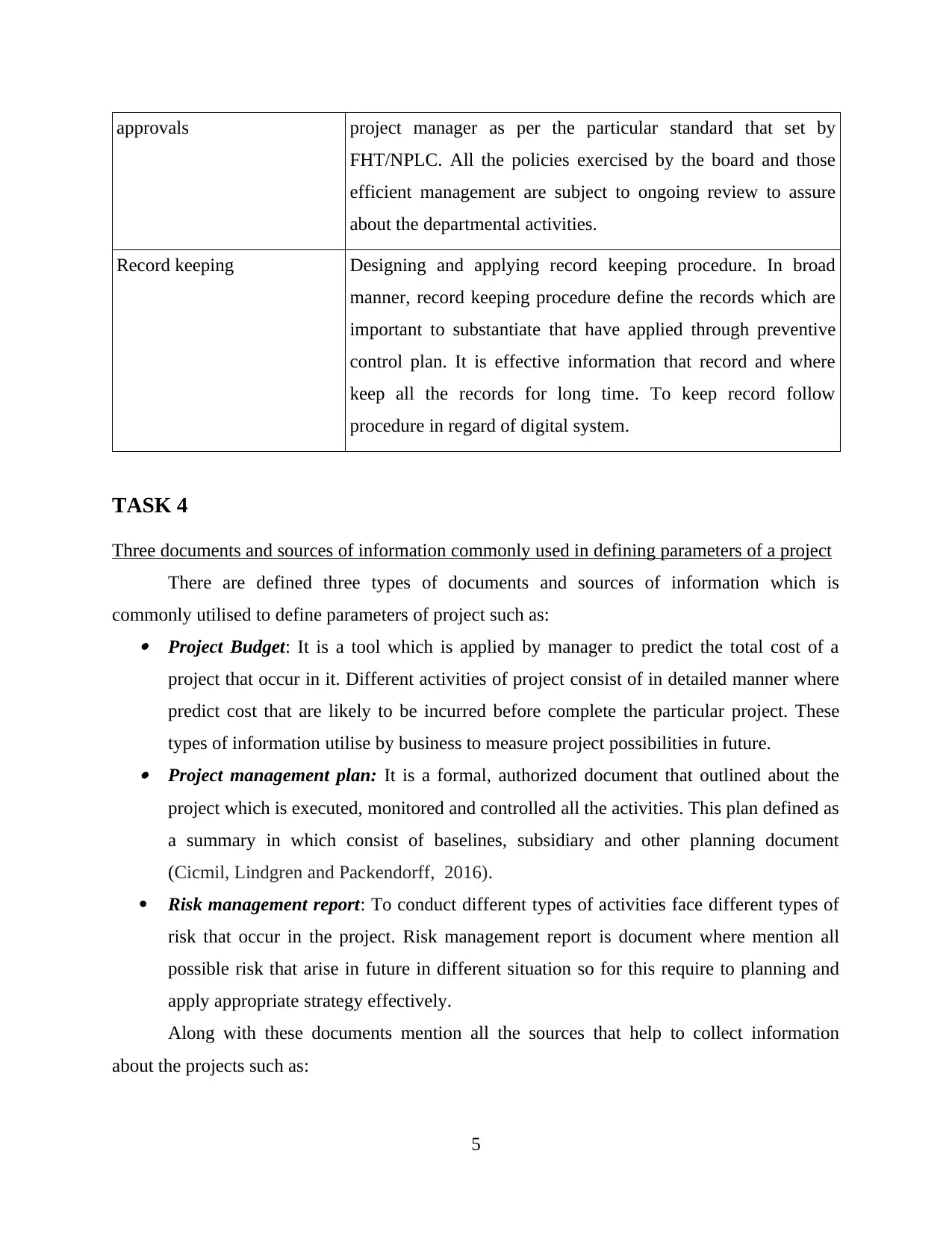
approvals project manager as per the particular standard that set by
FHT/NPLC. All the policies exercised by the board and those
efficient management are subject to ongoing review to assure
about the departmental activities.
Record keeping Designing and applying record keeping procedure. In broad
manner, record keeping procedure define the records which are
important to substantiate that have applied through preventive
control plan. It is effective information that record and where
keep all the records for long time. To keep record follow
procedure in regard of digital system.
TASK 4
Three documents and sources of information commonly used in defining parameters of a project
There are defined three types of documents and sources of information which is
commonly utilised to define parameters of project such as: Project Budget: It is a tool which is applied by manager to predict the total cost of a
project that occur in it. Different activities of project consist of in detailed manner where
predict cost that are likely to be incurred before complete the particular project. These
types of information utilise by business to measure project possibilities in future. Project management plan: It is a formal, authorized document that outlined about the
project which is executed, monitored and controlled all the activities. This plan defined as
a summary in which consist of baselines, subsidiary and other planning document
(Cicmil, Lindgren and Packendorff, 2016).
Risk management report: To conduct different types of activities face different types of
risk that occur in the project. Risk management report is document where mention all
possible risk that arise in future in different situation so for this require to planning and
apply appropriate strategy effectively.
Along with these documents mention all the sources that help to collect information
about the projects such as:
5
FHT/NPLC. All the policies exercised by the board and those
efficient management are subject to ongoing review to assure
about the departmental activities.
Record keeping Designing and applying record keeping procedure. In broad
manner, record keeping procedure define the records which are
important to substantiate that have applied through preventive
control plan. It is effective information that record and where
keep all the records for long time. To keep record follow
procedure in regard of digital system.
TASK 4
Three documents and sources of information commonly used in defining parameters of a project
There are defined three types of documents and sources of information which is
commonly utilised to define parameters of project such as: Project Budget: It is a tool which is applied by manager to predict the total cost of a
project that occur in it. Different activities of project consist of in detailed manner where
predict cost that are likely to be incurred before complete the particular project. These
types of information utilise by business to measure project possibilities in future. Project management plan: It is a formal, authorized document that outlined about the
project which is executed, monitored and controlled all the activities. This plan defined as
a summary in which consist of baselines, subsidiary and other planning document
(Cicmil, Lindgren and Packendorff, 2016).
Risk management report: To conduct different types of activities face different types of
risk that occur in the project. Risk management report is document where mention all
possible risk that arise in future in different situation so for this require to planning and
apply appropriate strategy effectively.
Along with these documents mention all the sources that help to collect information
about the projects such as:
5
Paraphrase This Document
Need a fresh take? Get an instant paraphrase of this document with our AI Paraphraser
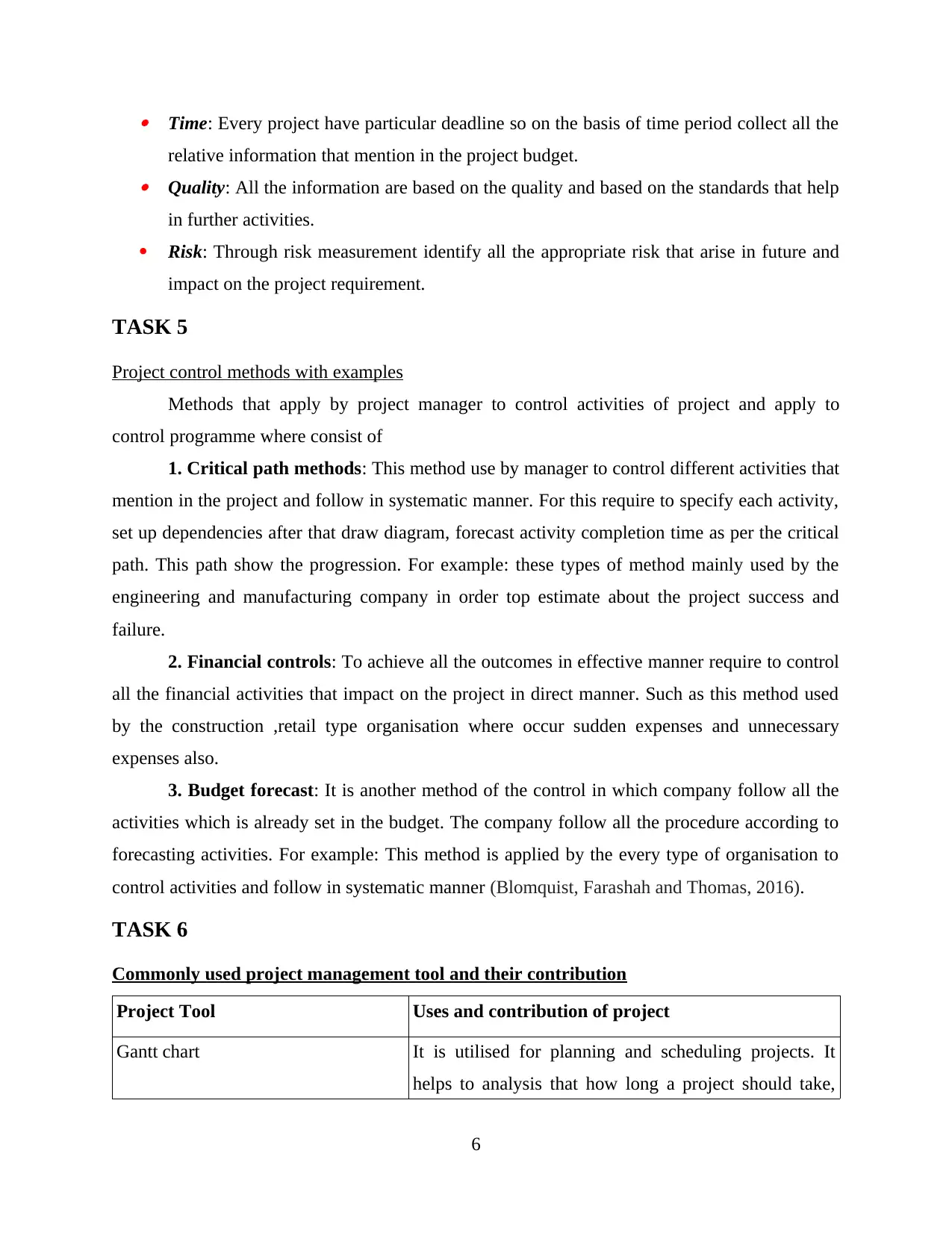
Time: Every project have particular deadline so on the basis of time period collect all the
relative information that mention in the project budget. Quality: All the information are based on the quality and based on the standards that help
in further activities.
Risk: Through risk measurement identify all the appropriate risk that arise in future and
impact on the project requirement.
TASK 5
Project control methods with examples
Methods that apply by project manager to control activities of project and apply to
control programme where consist of
1. Critical path methods: This method use by manager to control different activities that
mention in the project and follow in systematic manner. For this require to specify each activity,
set up dependencies after that draw diagram, forecast activity completion time as per the critical
path. This path show the progression. For example: these types of method mainly used by the
engineering and manufacturing company in order top estimate about the project success and
failure.
2. Financial controls: To achieve all the outcomes in effective manner require to control
all the financial activities that impact on the project in direct manner. Such as this method used
by the construction ,retail type organisation where occur sudden expenses and unnecessary
expenses also.
3. Budget forecast: It is another method of the control in which company follow all the
activities which is already set in the budget. The company follow all the procedure according to
forecasting activities. For example: This method is applied by the every type of organisation to
control activities and follow in systematic manner (Blomquist, Farashah and Thomas, 2016).
TASK 6
Commonly used project management tool and their contribution
Project Tool Uses and contribution of project
Gantt chart It is utilised for planning and scheduling projects. It
helps to analysis that how long a project should take,
6
relative information that mention in the project budget. Quality: All the information are based on the quality and based on the standards that help
in further activities.
Risk: Through risk measurement identify all the appropriate risk that arise in future and
impact on the project requirement.
TASK 5
Project control methods with examples
Methods that apply by project manager to control activities of project and apply to
control programme where consist of
1. Critical path methods: This method use by manager to control different activities that
mention in the project and follow in systematic manner. For this require to specify each activity,
set up dependencies after that draw diagram, forecast activity completion time as per the critical
path. This path show the progression. For example: these types of method mainly used by the
engineering and manufacturing company in order top estimate about the project success and
failure.
2. Financial controls: To achieve all the outcomes in effective manner require to control
all the financial activities that impact on the project in direct manner. Such as this method used
by the construction ,retail type organisation where occur sudden expenses and unnecessary
expenses also.
3. Budget forecast: It is another method of the control in which company follow all the
activities which is already set in the budget. The company follow all the procedure according to
forecasting activities. For example: This method is applied by the every type of organisation to
control activities and follow in systematic manner (Blomquist, Farashah and Thomas, 2016).
TASK 6
Commonly used project management tool and their contribution
Project Tool Uses and contribution of project
Gantt chart It is utilised for planning and scheduling projects. It
helps to analysis that how long a project should take,
6
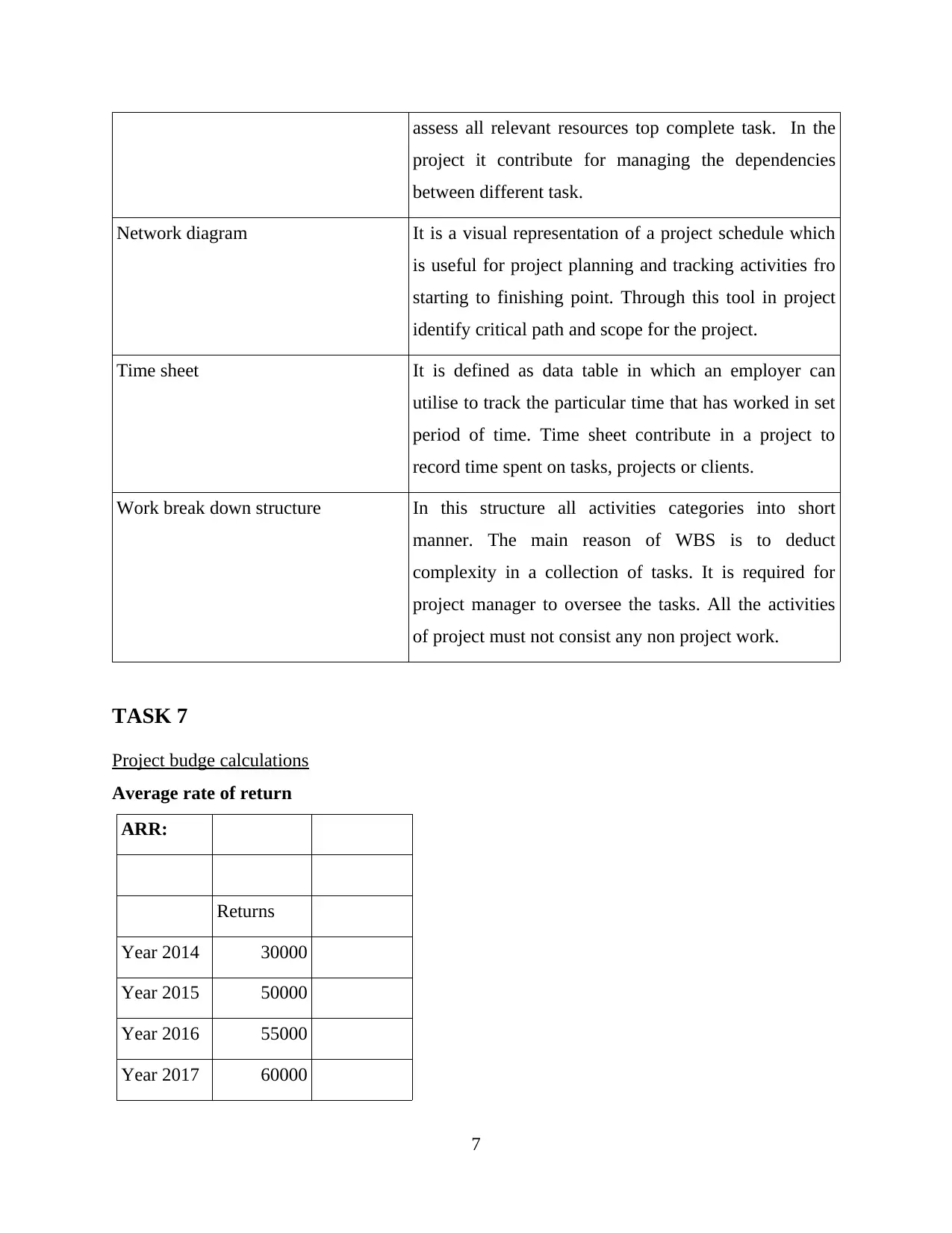
assess all relevant resources top complete task. In the
project it contribute for managing the dependencies
between different task.
Network diagram It is a visual representation of a project schedule which
is useful for project planning and tracking activities fro
starting to finishing point. Through this tool in project
identify critical path and scope for the project.
Time sheet It is defined as data table in which an employer can
utilise to track the particular time that has worked in set
period of time. Time sheet contribute in a project to
record time spent on tasks, projects or clients.
Work break down structure In this structure all activities categories into short
manner. The main reason of WBS is to deduct
complexity in a collection of tasks. It is required for
project manager to oversee the tasks. All the activities
of project must not consist any non project work.
TASK 7
Project budge calculations
Average rate of return
ARR:
Returns
Year 2014 30000
Year 2015 50000
Year 2016 55000
Year 2017 60000
7
project it contribute for managing the dependencies
between different task.
Network diagram It is a visual representation of a project schedule which
is useful for project planning and tracking activities fro
starting to finishing point. Through this tool in project
identify critical path and scope for the project.
Time sheet It is defined as data table in which an employer can
utilise to track the particular time that has worked in set
period of time. Time sheet contribute in a project to
record time spent on tasks, projects or clients.
Work break down structure In this structure all activities categories into short
manner. The main reason of WBS is to deduct
complexity in a collection of tasks. It is required for
project manager to oversee the tasks. All the activities
of project must not consist any non project work.
TASK 7
Project budge calculations
Average rate of return
ARR:
Returns
Year 2014 30000
Year 2015 50000
Year 2016 55000
Year 2017 60000
7
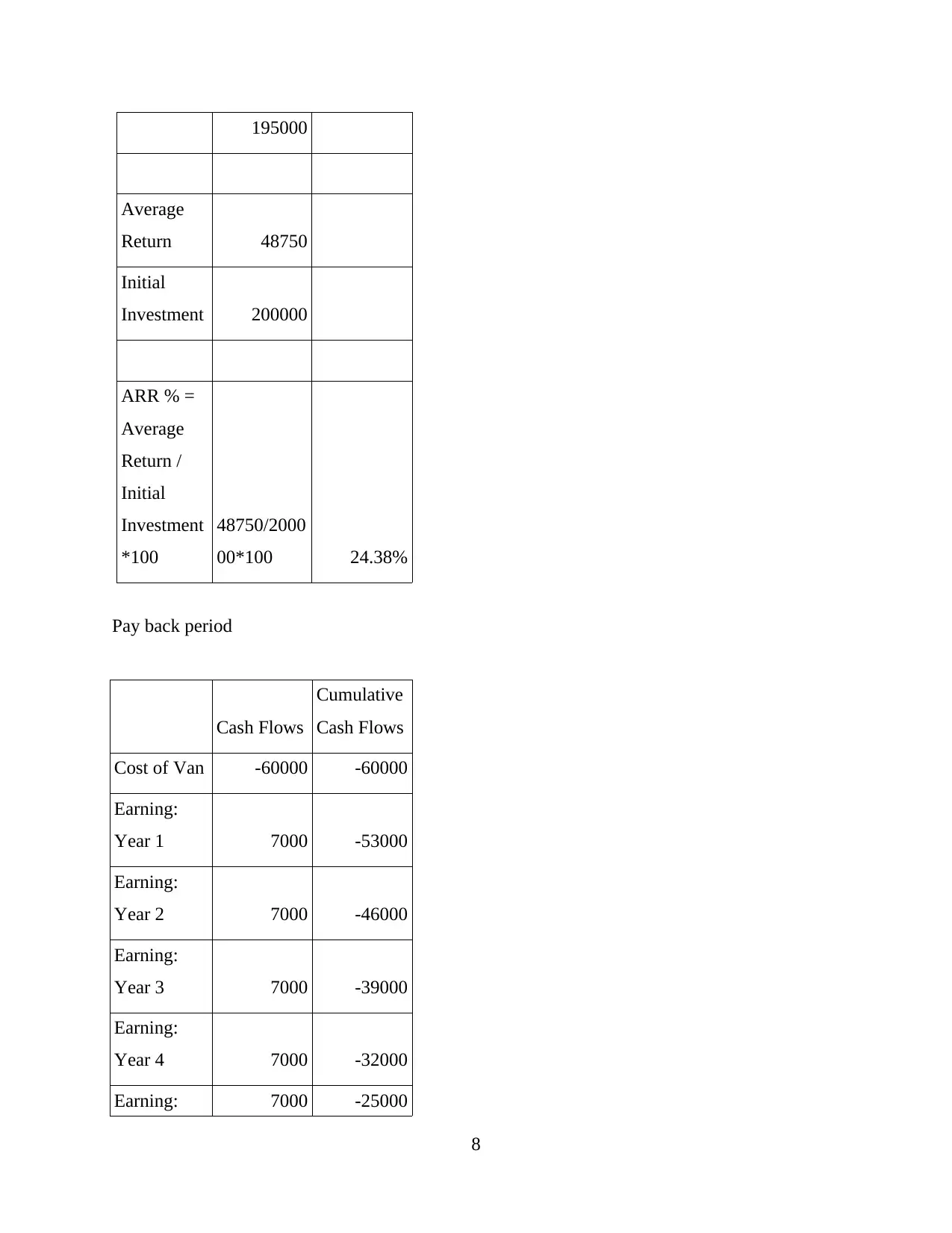
195000
Average
Return 48750
Initial
Investment 200000
ARR % =
Average
Return /
Initial
Investment
*100
48750/2000
00*100 24.38%
Pay back period
Cash Flows
Cumulative
Cash Flows
Cost of Van -60000 -60000
Earning:
Year 1 7000 -53000
Earning:
Year 2 7000 -46000
Earning:
Year 3 7000 -39000
Earning:
Year 4 7000 -32000
Earning: 7000 -25000
8
Average
Return 48750
Initial
Investment 200000
ARR % =
Average
Return /
Initial
Investment
*100
48750/2000
00*100 24.38%
Pay back period
Cash Flows
Cumulative
Cash Flows
Cost of Van -60000 -60000
Earning:
Year 1 7000 -53000
Earning:
Year 2 7000 -46000
Earning:
Year 3 7000 -39000
Earning:
Year 4 7000 -32000
Earning: 7000 -25000
8
Secure Best Marks with AI Grader
Need help grading? Try our AI Grader for instant feedback on your assignments.
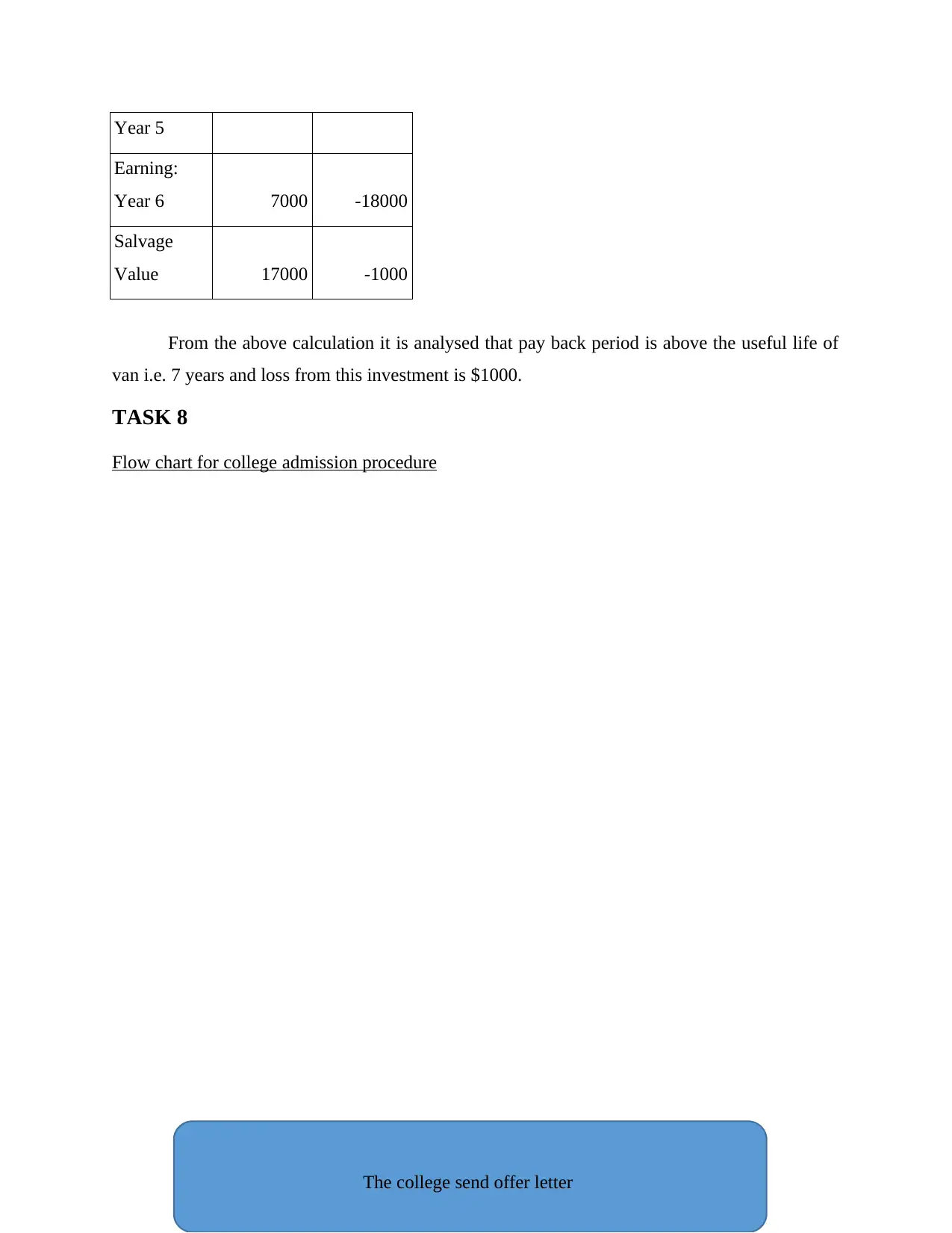
Year 5
Earning:
Year 6 7000 -18000
Salvage
Value 17000 -1000
From the above calculation it is analysed that pay back period is above the useful life of
van i.e. 7 years and loss from this investment is $1000.
TASK 8
Flow chart for college admission procedure
9
The college send offer letter
Earning:
Year 6 7000 -18000
Salvage
Value 17000 -1000
From the above calculation it is analysed that pay back period is above the useful life of
van i.e. 7 years and loss from this investment is $1000.
TASK 8
Flow chart for college admission procedure
9
The college send offer letter
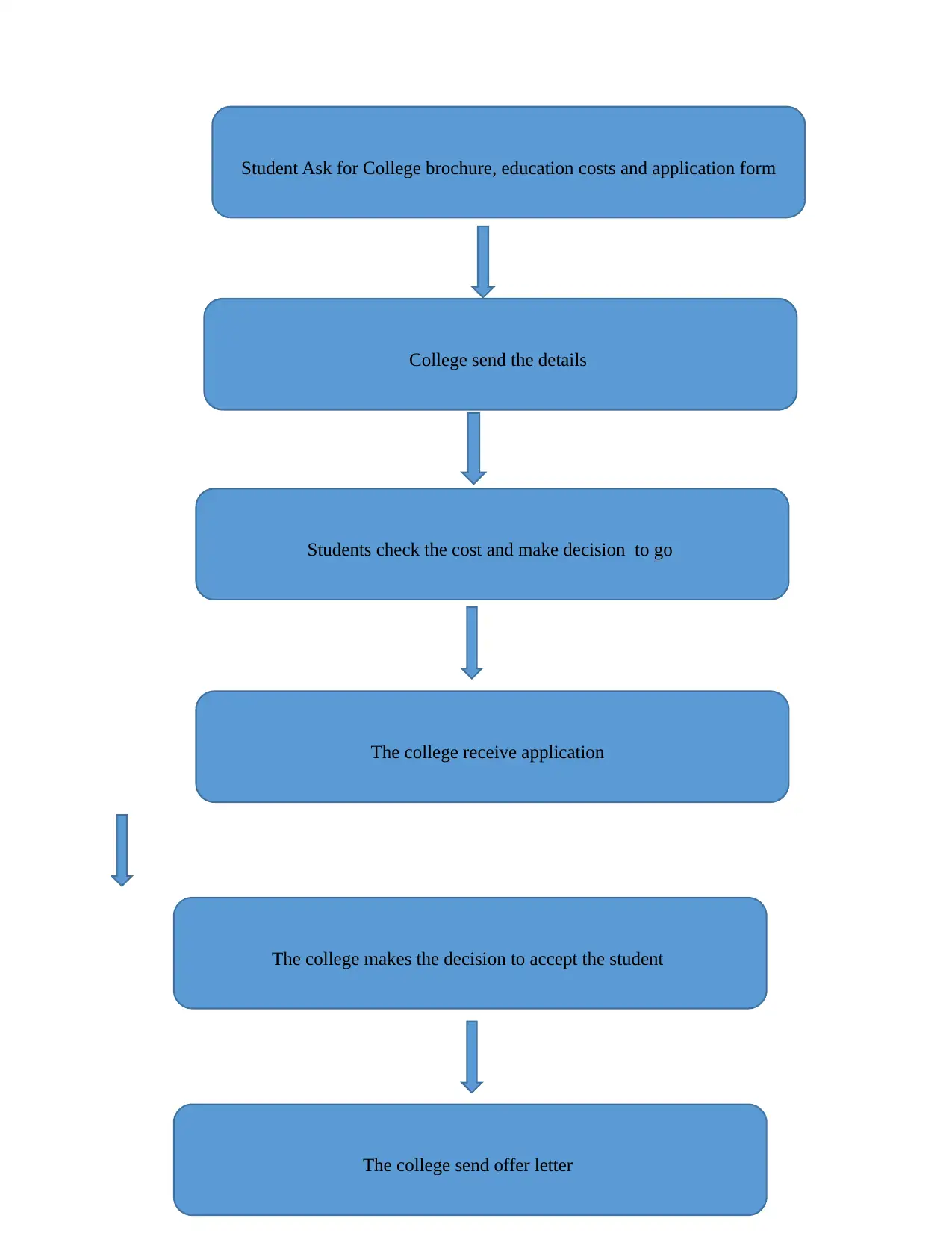
10
Students check the cost and make decision to go
College send the details
Student Ask for College brochure, education costs and application form
The college receive application
The college makes the decision to accept the student
The college send offer letter
Students check the cost and make decision to go
College send the details
Student Ask for College brochure, education costs and application form
The college receive application
The college makes the decision to accept the student
The college send offer letter
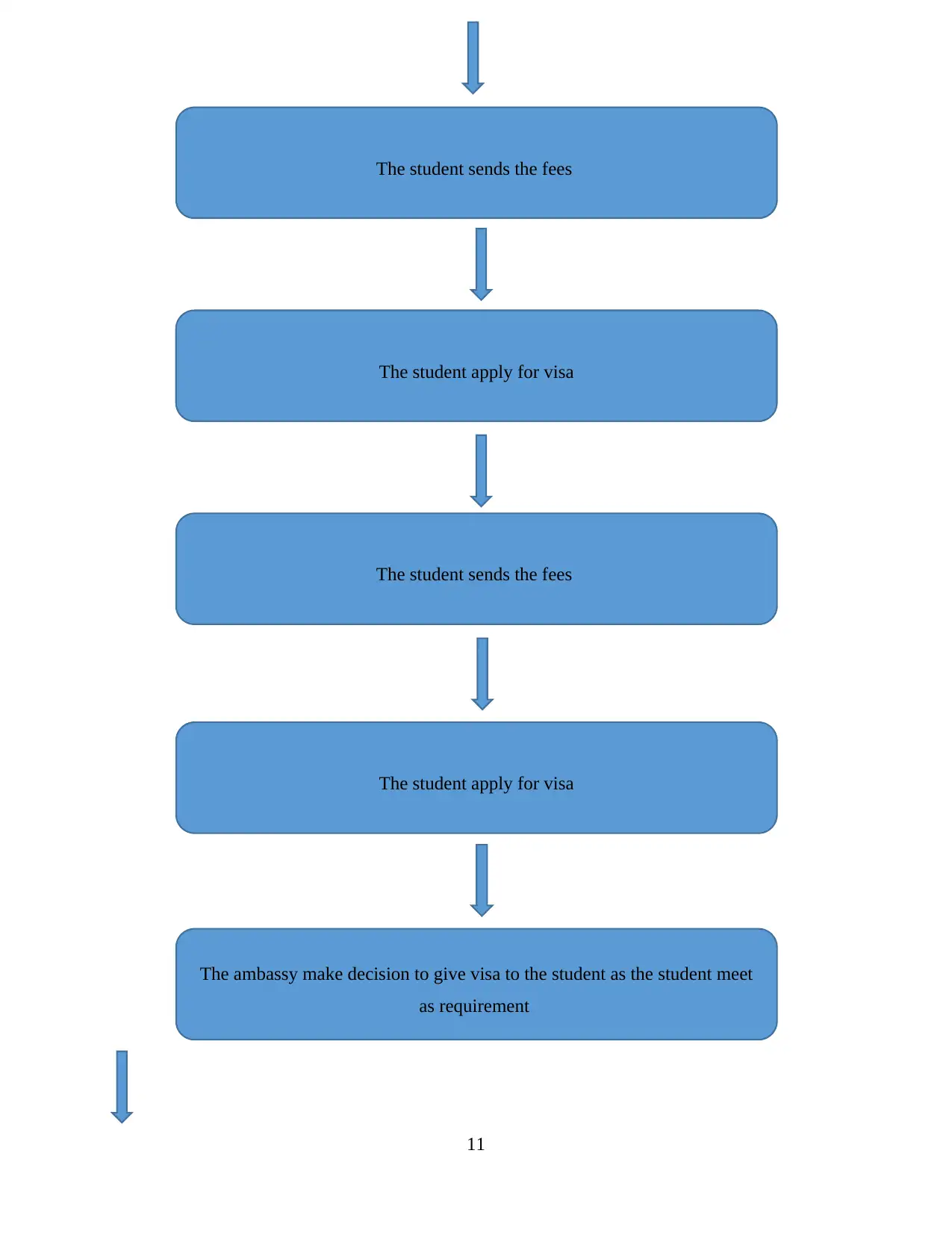
11
The student apply for visa
The student sends the fees
The student apply for visa
The ambassy make decision to give visa to the student as the student meet
as requirement
The student sends the fees
The student apply for visa
The student sends the fees
The student apply for visa
The ambassy make decision to give visa to the student as the student meet
as requirement
The student sends the fees
Paraphrase This Document
Need a fresh take? Get an instant paraphrase of this document with our AI Paraphraser
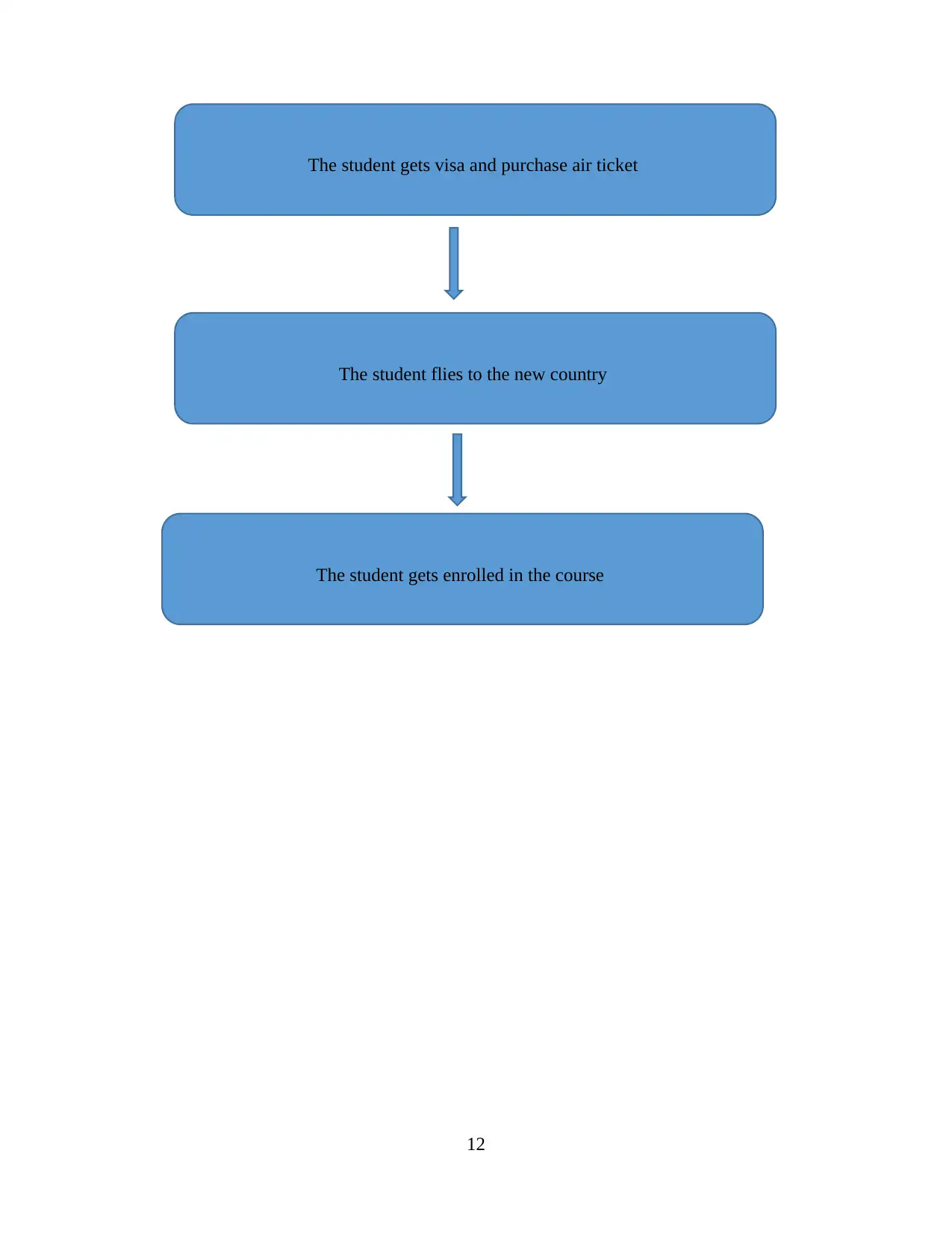
The student apply for visa
12
The student gets visa and purchase air ticket
The student flies to the new country
The student gets enrolled in the course
12
The student gets visa and purchase air ticket
The student flies to the new country
The student gets enrolled in the course
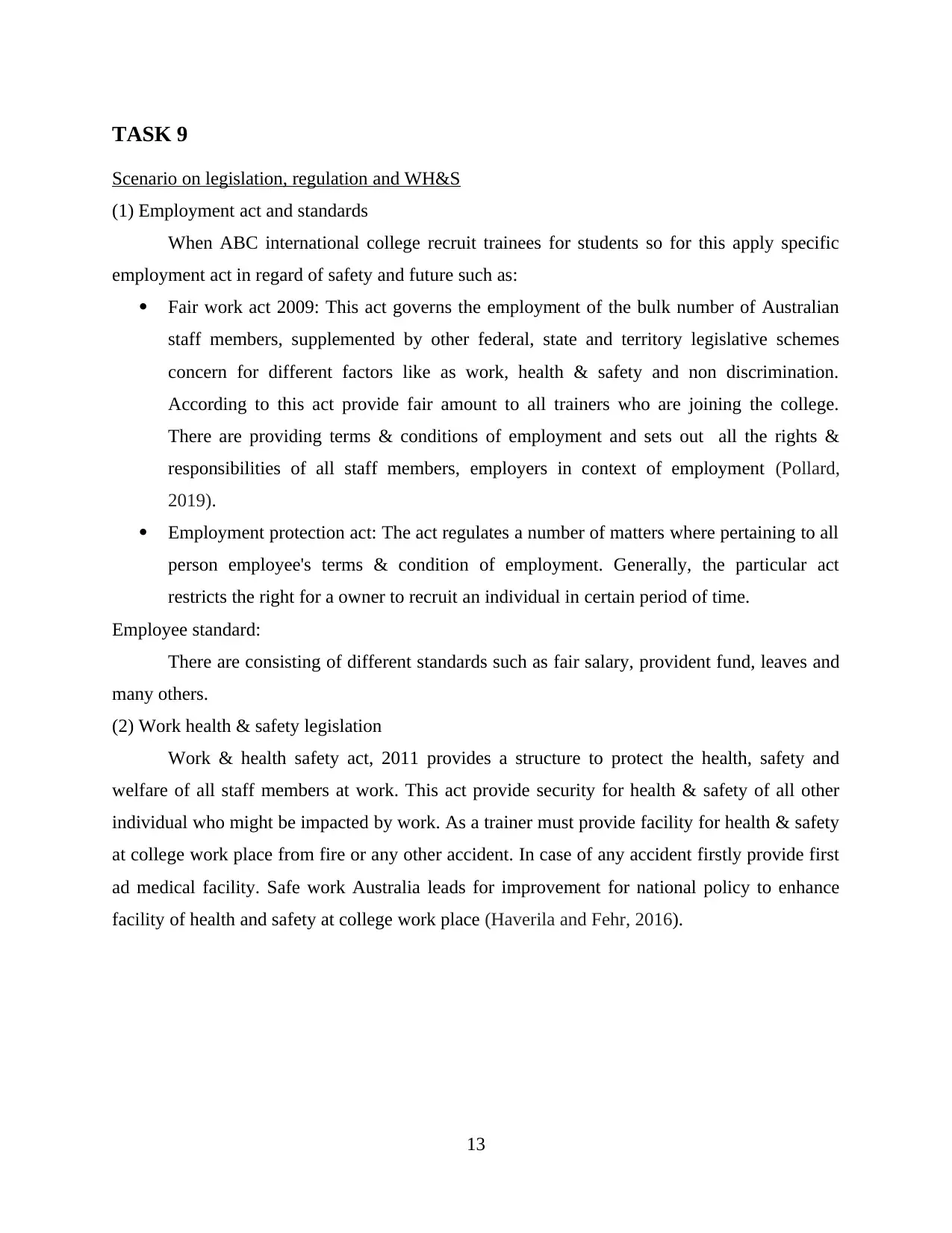
TASK 9
Scenario on legislation, regulation and WH&S
(1) Employment act and standards
When ABC international college recruit trainees for students so for this apply specific
employment act in regard of safety and future such as:
Fair work act 2009: This act governs the employment of the bulk number of Australian
staff members, supplemented by other federal, state and territory legislative schemes
concern for different factors like as work, health & safety and non discrimination.
According to this act provide fair amount to all trainers who are joining the college.
There are providing terms & conditions of employment and sets out all the rights &
responsibilities of all staff members, employers in context of employment (Pollard,
2019).
Employment protection act: The act regulates a number of matters where pertaining to all
person employee's terms & condition of employment. Generally, the particular act
restricts the right for a owner to recruit an individual in certain period of time.
Employee standard:
There are consisting of different standards such as fair salary, provident fund, leaves and
many others.
(2) Work health & safety legislation
Work & health safety act, 2011 provides a structure to protect the health, safety and
welfare of all staff members at work. This act provide security for health & safety of all other
individual who might be impacted by work. As a trainer must provide facility for health & safety
at college work place from fire or any other accident. In case of any accident firstly provide first
ad medical facility. Safe work Australia leads for improvement for national policy to enhance
facility of health and safety at college work place (Haverila and Fehr, 2016).
13
Scenario on legislation, regulation and WH&S
(1) Employment act and standards
When ABC international college recruit trainees for students so for this apply specific
employment act in regard of safety and future such as:
Fair work act 2009: This act governs the employment of the bulk number of Australian
staff members, supplemented by other federal, state and territory legislative schemes
concern for different factors like as work, health & safety and non discrimination.
According to this act provide fair amount to all trainers who are joining the college.
There are providing terms & conditions of employment and sets out all the rights &
responsibilities of all staff members, employers in context of employment (Pollard,
2019).
Employment protection act: The act regulates a number of matters where pertaining to all
person employee's terms & condition of employment. Generally, the particular act
restricts the right for a owner to recruit an individual in certain period of time.
Employee standard:
There are consisting of different standards such as fair salary, provident fund, leaves and
many others.
(2) Work health & safety legislation
Work & health safety act, 2011 provides a structure to protect the health, safety and
welfare of all staff members at work. This act provide security for health & safety of all other
individual who might be impacted by work. As a trainer must provide facility for health & safety
at college work place from fire or any other accident. In case of any accident firstly provide first
ad medical facility. Safe work Australia leads for improvement for national policy to enhance
facility of health and safety at college work place (Haverila and Fehr, 2016).
13
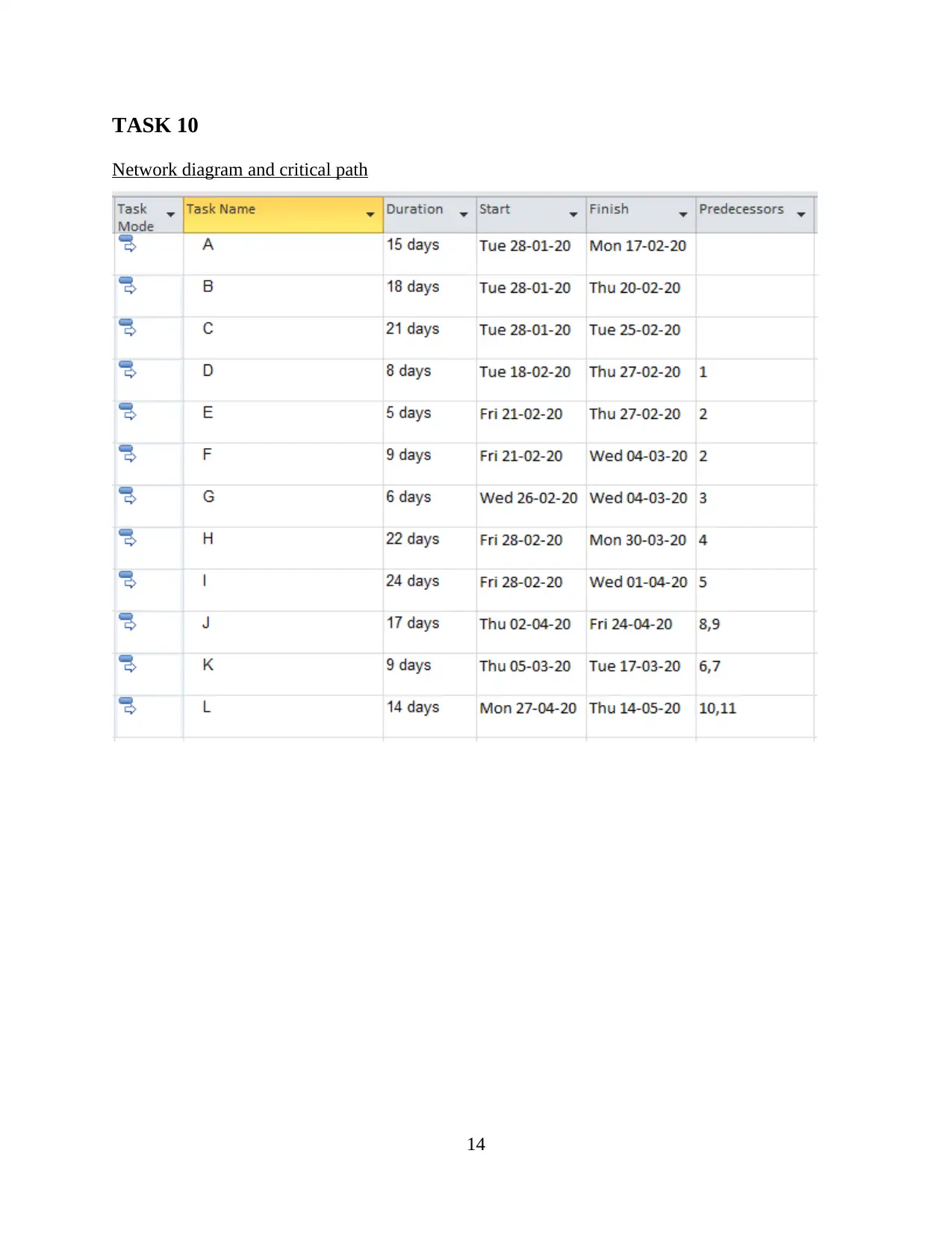
TASK 10
Network diagram and critical path
14
Network diagram and critical path
14
Secure Best Marks with AI Grader
Need help grading? Try our AI Grader for instant feedback on your assignments.
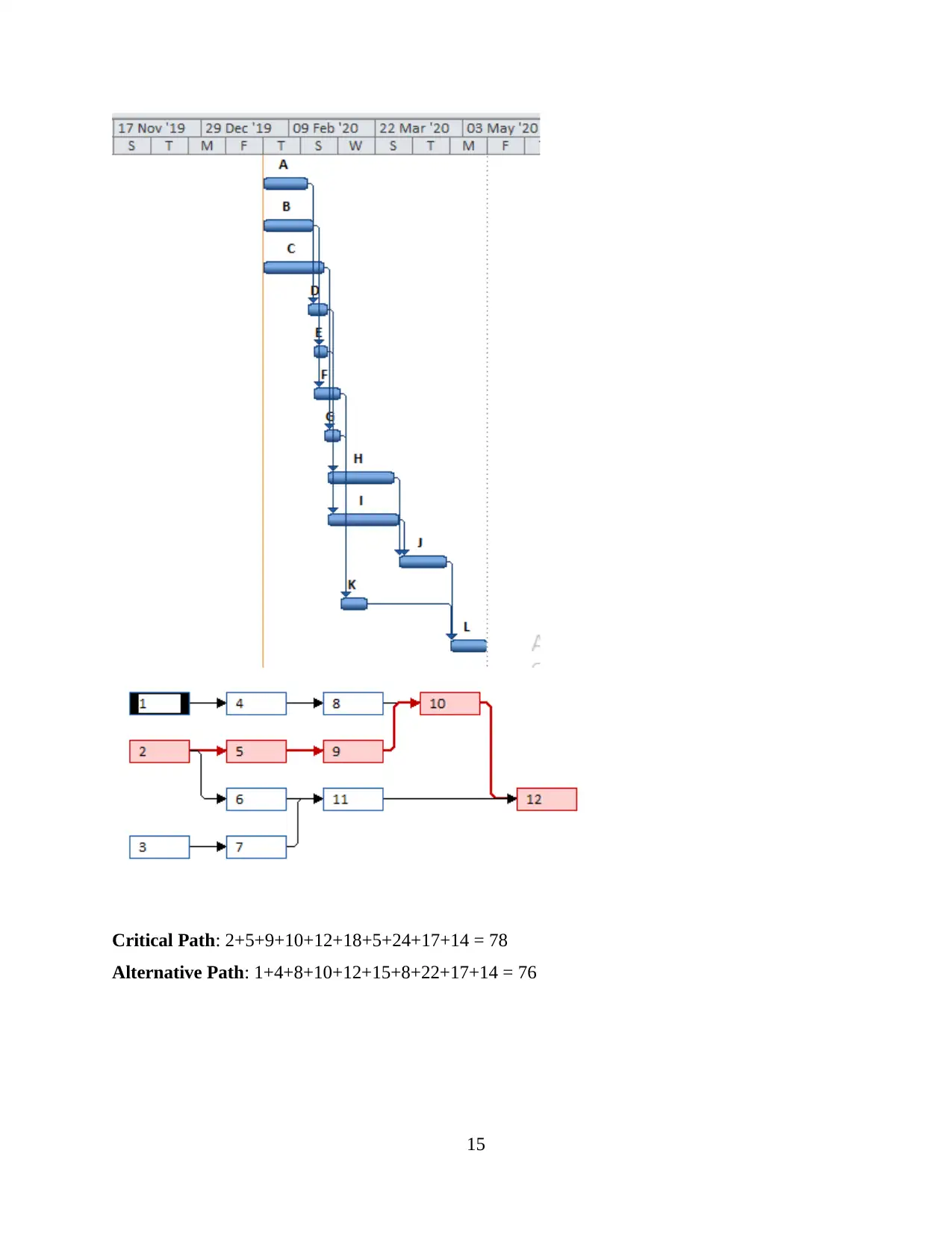
Critical Path: 2+5+9+10+12+18+5+24+17+14 = 78
Alternative Path: 1+4+8+10+12+15+8+22+17+14 = 76
15
Alternative Path: 1+4+8+10+12+15+8+22+17+14 = 76
15
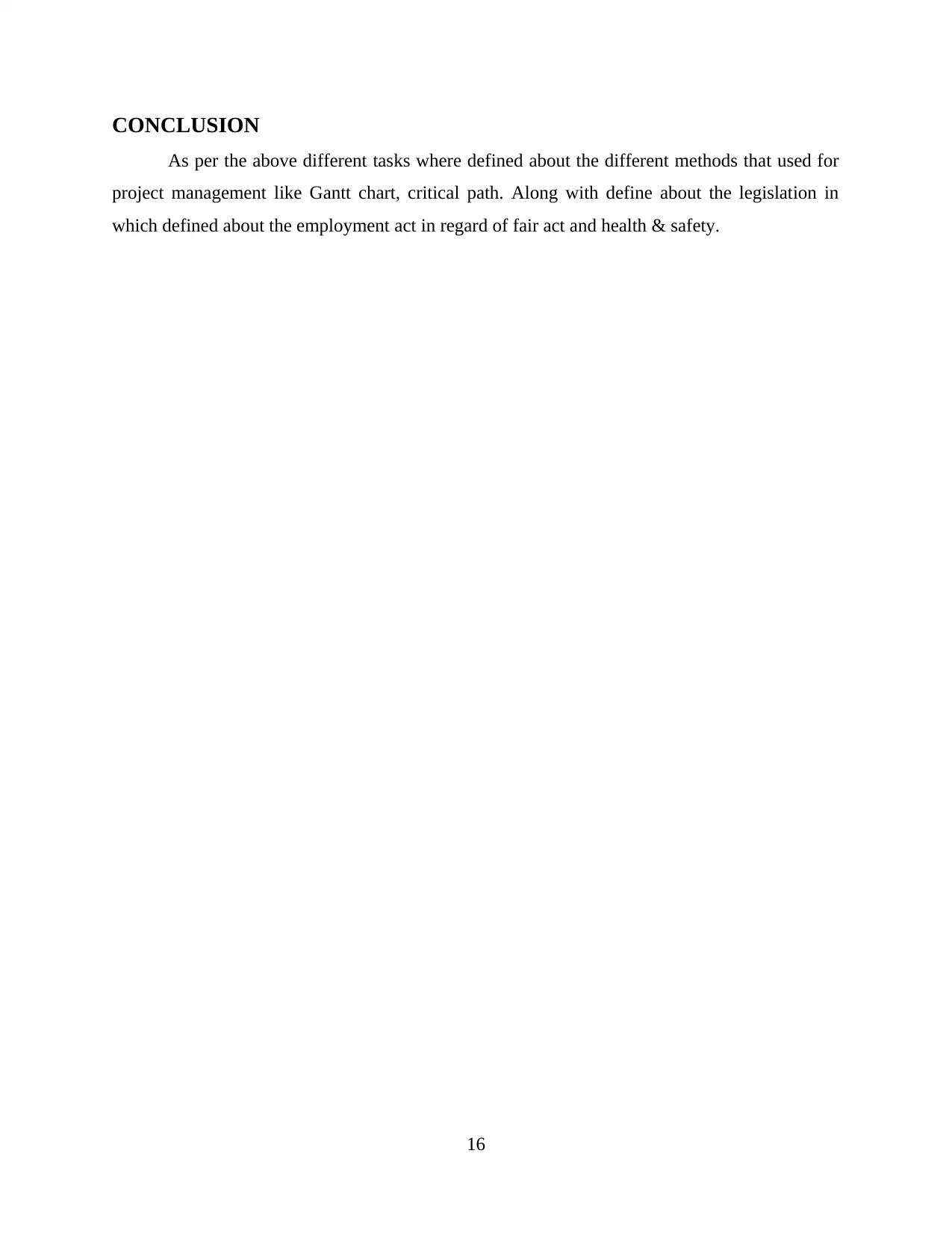
CONCLUSION
As per the above different tasks where defined about the different methods that used for
project management like Gantt chart, critical path. Along with define about the legislation in
which defined about the employment act in regard of fair act and health & safety.
16
As per the above different tasks where defined about the different methods that used for
project management like Gantt chart, critical path. Along with define about the legislation in
which defined about the employment act in regard of fair act and health & safety.
16
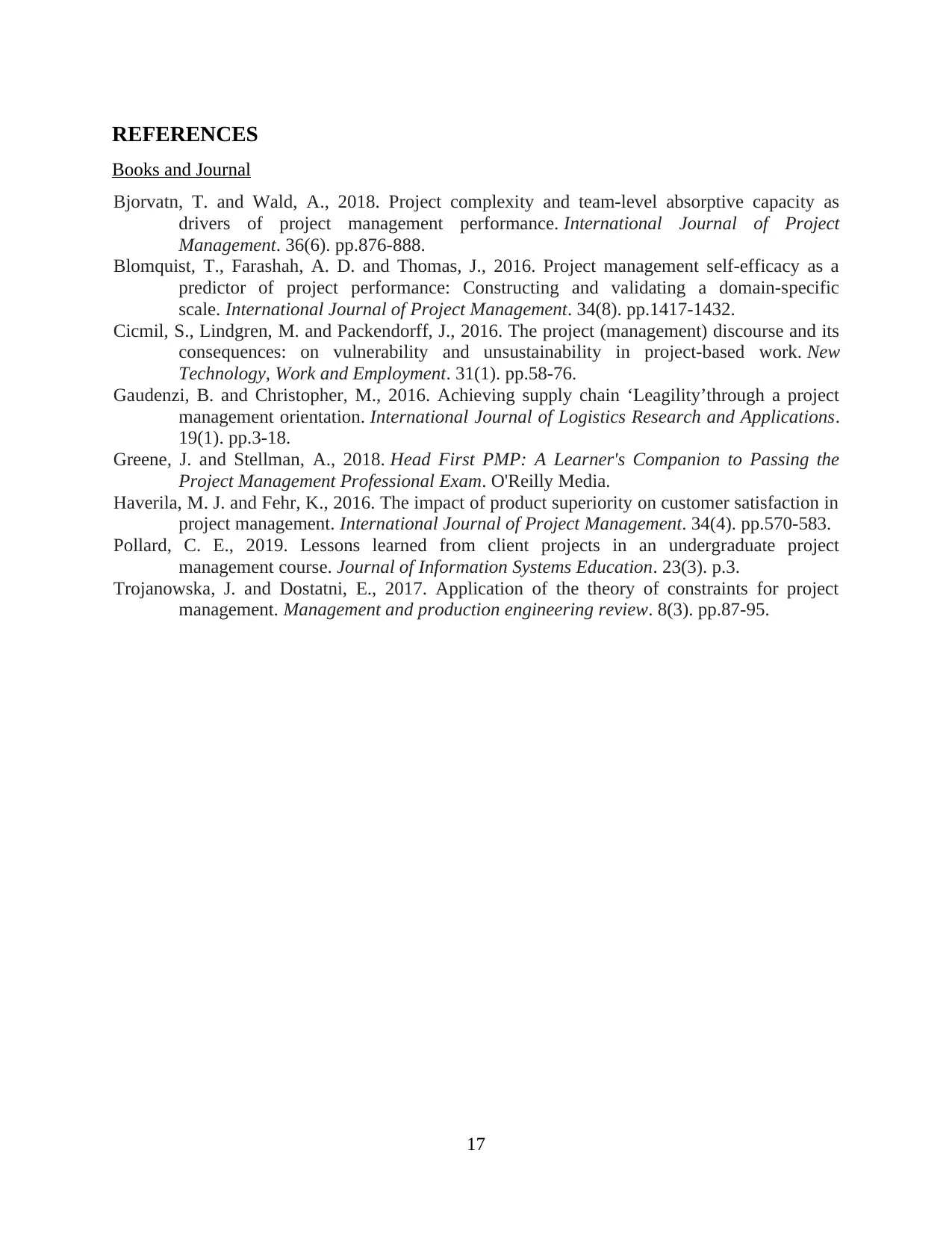
REFERENCES
Books and Journal
Bjorvatn, T. and Wald, A., 2018. Project complexity and team-level absorptive capacity as
drivers of project management performance. International Journal of Project
Management. 36(6). pp.876-888.
Blomquist, T., Farashah, A. D. and Thomas, J., 2016. Project management self-efficacy as a
predictor of project performance: Constructing and validating a domain-specific
scale. International Journal of Project Management. 34(8). pp.1417-1432.
Cicmil, S., Lindgren, M. and Packendorff, J., 2016. The project (management) discourse and its
consequences: on vulnerability and unsustainability in project‐based work. New
Technology, Work and Employment. 31(1). pp.58-76.
Gaudenzi, B. and Christopher, M., 2016. Achieving supply chain ‘Leagility’through a project
management orientation. International Journal of Logistics Research and Applications.
19(1). pp.3-18.
Greene, J. and Stellman, A., 2018. Head First PMP: A Learner's Companion to Passing the
Project Management Professional Exam. O'Reilly Media.
Haverila, M. J. and Fehr, K., 2016. The impact of product superiority on customer satisfaction in
project management. International Journal of Project Management. 34(4). pp.570-583.
Pollard, C. E., 2019. Lessons learned from client projects in an undergraduate project
management course. Journal of Information Systems Education. 23(3). p.3.
Trojanowska, J. and Dostatni, E., 2017. Application of the theory of constraints for project
management. Management and production engineering review. 8(3). pp.87-95.
17
Books and Journal
Bjorvatn, T. and Wald, A., 2018. Project complexity and team-level absorptive capacity as
drivers of project management performance. International Journal of Project
Management. 36(6). pp.876-888.
Blomquist, T., Farashah, A. D. and Thomas, J., 2016. Project management self-efficacy as a
predictor of project performance: Constructing and validating a domain-specific
scale. International Journal of Project Management. 34(8). pp.1417-1432.
Cicmil, S., Lindgren, M. and Packendorff, J., 2016. The project (management) discourse and its
consequences: on vulnerability and unsustainability in project‐based work. New
Technology, Work and Employment. 31(1). pp.58-76.
Gaudenzi, B. and Christopher, M., 2016. Achieving supply chain ‘Leagility’through a project
management orientation. International Journal of Logistics Research and Applications.
19(1). pp.3-18.
Greene, J. and Stellman, A., 2018. Head First PMP: A Learner's Companion to Passing the
Project Management Professional Exam. O'Reilly Media.
Haverila, M. J. and Fehr, K., 2016. The impact of product superiority on customer satisfaction in
project management. International Journal of Project Management. 34(4). pp.570-583.
Pollard, C. E., 2019. Lessons learned from client projects in an undergraduate project
management course. Journal of Information Systems Education. 23(3). p.3.
Trojanowska, J. and Dostatni, E., 2017. Application of the theory of constraints for project
management. Management and production engineering review. 8(3). pp.87-95.
17
1 out of 19
Related Documents
Your All-in-One AI-Powered Toolkit for Academic Success.
+13062052269
info@desklib.com
Available 24*7 on WhatsApp / Email
![[object Object]](/_next/static/media/star-bottom.7253800d.svg)
Unlock your academic potential
© 2024 | Zucol Services PVT LTD | All rights reserved.





